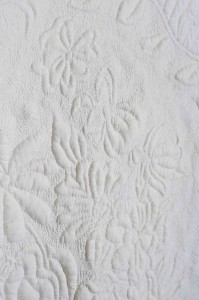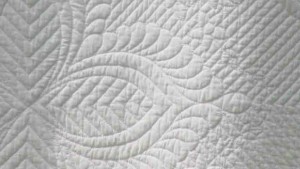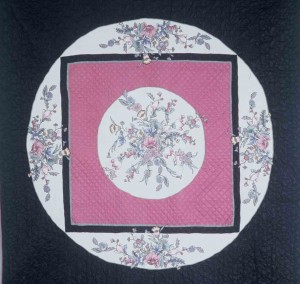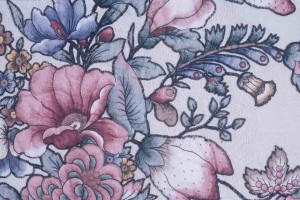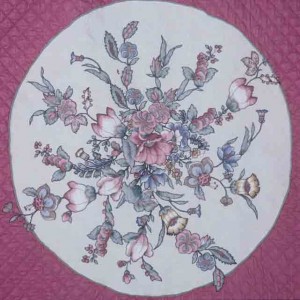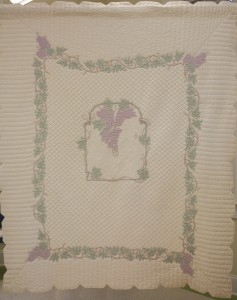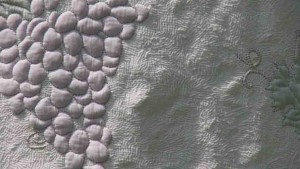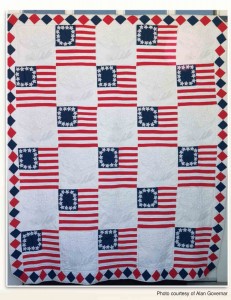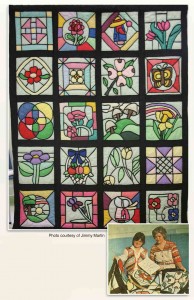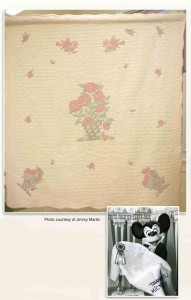Bettye Kimbrell made a number of white-on-white quilts which showcase her extraordinary skill at hand-stitching. With a pencil she drew patterns on white fabric—sometimes original motifs, sometimes traditional designs using commercial stencils—then stitched over them with white thread, each stitch going through the top, batting, and back of the quilt. Designs emerged from the richly textured background. Bettye enhanced many of her white-on-white quilts with stippling. Stippling is a technique in which stitches are placed as close to each other as possible without touching. The designs that are surrounded by stippling become embossed, though they have not been stuffed.
Category Archives: Quilts
California Star
When Bettye needed “R&R” during or after making a highly complicated quilt she would turn to a simpler design such as the “Feathered Star” or “California Star.” She called this one her “cancer recovery” quilt because she worked on it while dealing with uterine cancer. It ended up on the cover of Star Quilts, by Mary Elizabeth Johnson Huff. (Photo courtesy of Jimmy Martin)
82” W X94”L ( 1979)
Broderie Perse
This quilt is one of three quilts made by Bettye Kimbrell using a technique called broderie perse, meaning Persian embroidery. It involves cutting floral designs out of chintz material and reassembling them into a different pattern on a quilt top. Bettye said, “I took a piece of chintz fabric, noted the clusters of flowers on it that I wanted to use in my quilt and did a rough cut around them. To attach them to my quilt top I cut away—a half inch at a time—all the background fabric from the chintz design. I appliquéd that half-inch to the top using a button-hole stitch around the edge of each leaf, stem and flower in the design, then trimmed away another half inch of the chintz and stitched it to the piece. I kept cutting and stitching a half-inch at a time until I had a quilt top full of chintz flowers arranged the way I wanted them. It was tedious and really difficult to do. It took me five years, with R&R breaks, to finish it.”
34” W X46”L (1989)
Cindy’s Vineyard
This is the second shadow trapunto quilt that Cindy Denton designed and Bettye Kimbrell quilted. Each grape on the quilt is stuffed with bright purple yarn and each leaf is stuffed with an intense green yarn. They appear pale and hazy seen through the quilt’s sheer batiste top. There is a large amount of stippling around the main design elements. Stippling consists of tiny stitches placed as close to each other as they can be without touching. It took Bettye 3 years to complete “Cindy’s Vineyard.”
77” W X 89”L (1992)
Bicentennial Quilt
Bettye created this this quilt in 1975 for a competition sponsored by the National Grange to celebrate the 200th anniversary of the United States. It has a patchwork design made up of twelve blocks that look like Betsy Ross’s 1776 flag with its red and white stripes and thirteen blue stars alternating with white squares filled with hand-stitched outlines of eagles and stars. (Photo courtesy of Alan Govenar)
81” W X96” L (1975)
Our Constitution
In 1987 Bettye and her three daughters, Kathy, Nina, and Cindy, designed this quilt for a competition sponsored by the Southern Highlands Craft Guild celebrating the 200th anniversary of the U.S. Constitution. The woman in the center is working on a quilt of 20 squares, the type that Bettye’s grandmother, Julia Whitson, made. Each square has an 8-point star in the center. A threaded needle is left in the hoop to show that the quilt is not finished. The quilting is done in a traditional shell pattern, also echoing her grandmother’s work. (Photo courtesy of Alan Govenar)
71” W X71”L (1987)
Stained Glass Quilt
In this type of quilt figures are cut out of cloth and appliquéd to squares in a manner that imitates stained glass. Each figure is edged in dark fabric to represent the leading that joins the individual pieces of glass into one image and the squares are joined with strips that create the appearance of window panes. Bettye’s youngest daughter, Cindy Denton, shown with her mother in the photo below, drew each of the figures that Bettye used in making the quilt. (Photo of quilt courtesy of Jimmy Martin)
82” W X93”L (1982)
Cindy’s Rose
This is Bettye’s first shadow trapunto quilt. “Trapunto” is a form of quilting in which figures are outlined in stitches then stuffed with extra batting to make them rise above the surface of the quilt. In “shadow trapunto” the top layer is a sheer batiste fabric. When figures are stuffed with brightly colored yarn, the designs take on a soft, hazy appearance. The stuffing is usually done from the back of the quilt, but Bettye, devised a way to stuff the yarn in from the top with a tapestry needle. This quilt, designed by Cindy Denton, won Best of Show at the Alabama State Fair and got the same honor at Disneyland in California when shown with winners from other state fairs across the country. (Photo of quilt courtesy of Jimmy Martin)
82” L X 78” W (1985)

